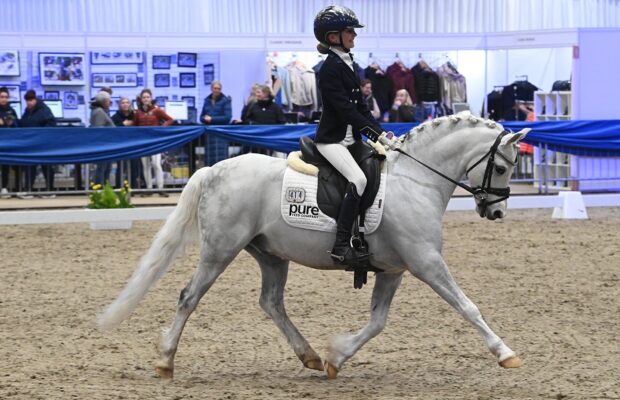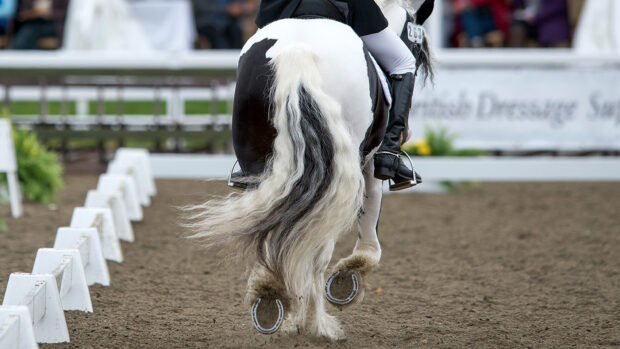At its most basic, understanding how to use leg pressure when riding a horse is simple. You are asking the horse to yield away from your leg, so using one leg moves the horse sideways away from the pressure on that side, while using both legs means you are asking the horse to go forwards. Sounds easy. But achieving the desired reaction while consistently using the lightest of aids requires a rider with the ability to use the right amount of pressure at the right time and in the right place.
How to get a response
The first step in how to use leg pressure when riding a horse, is to teach the horse to react to a gentle or light leg aid. This is critical to training a horse, whatever the discipline or level the horse is working at.
Dressage legend Kyra Kyrklund explains: “A horse feels a fly land on his skin, so ideally, he should be listening to a whisper. Think of aids – whether hand, leg or weight – in terms of small, medium, large and extra-large. If you don’t get a response from a small aid, use medium, then large. You might need to use extra-large, but it is important you always go back to small next time, otherwise the horse will shut off. If you start to use a bit more leg, and a bit more leg, then it doesn’t mean anything anymore.”
Kyra also warns of another common misconception: “I have seen riders across all disciplines squeezing with their legs all the time. Do not squeeze! If you do this, you literally squeeze yourself out of the saddle. Also, squeezing tenses muscles and having tense muscles means you don’t ‘feel’ as much as much as you do with a relaxed muscle. Basically, if a horse doesn’t respond to the leg aid, the answer does not involve squeezing more with the leg.
“The leg aid is like an ‘impulsion’. Think of how the horse reacts to a tap of the whip. If there is no reaction, you don’t squeeze with the whip. You tap again, maybe a bit sharper. The same goes for the leg aid.
“A sensitive horse may need a bit more of a calf contact not to overreact, otherwise it will be like an electric shock for the horse when you put your leg on. Imagine you have a spring between your calf and the horse. You don’t want to squeeze the spring together, but neither do you want to let it go.
“If the horse is working as you want, you should be able to sit still and not use your leg aid. As with all aids, not influencing the horse is his reward. The horse then learns it is the easiest way of going.”
Dressage rider and trainer Damian Hallam, who is a former event rider and showjumper, expands to explain why consistency is key: “You praise the horse by switching off the leg aid and I also use my voice to reward him. Reward is something that should be easy for the horse to pick up on, which is why you need to be consistent.”
Riding transitions between the paces as well as within paces gives Damian valuable feedback to check responsiveness: “The horse will only improve if the rider is consistent in what he expects. Transitions are the framework of training the horse to react to the rider’s aids. They provide valuable information as to whether the horse is listening to the commands.
“So often, riders will recognise a transition wasn’t good enough, but not go back and explain to the horse how he needs to do it better. The horse’s reactions will only improve if the rider is consistent in what he expects.”
How to use leg pressure when riding a horse
When using the leg aid to maintain impulsion, Kyra uses an interesting analogy: “It is a bit like riding a pushbike. You pedal to gain a certain speed. To maintain a constant speed, you don’t pedal all the time. You only pedal when you are going too slowly.
“We’ve all heard a trainer say ‘more leg’, but what does ‘more leg’ actually mean? You have to understand what they are asking. Are they asking for a longer stride in the same rhythm or a shorter step in the same rhythm or a quicker rhythm?”
Check how well your horse is responding to your leg aid by riding transitions. Start with the easiest, halt to walk, repeating the transition until the horse moves off immediately with a light aid. Reward your horse straight away for his response by “switching off” the aid and not influencing him. Make sure your hands are soft and giving when you apply the leg aid; it is easy to become tense and inadvertently “block” the horse.
The aim
Once you have achieved “whisper” leg-aid responsiveness, then you can start to influence the horse to a whole new level.
Kyra says: “I try to use my leg in the rhythm I want the horse to go, like a dance partner, but I want him to follow me, I don’t follow him. I have to be the one who is leading the dance. If you use your leg quicker, then you can make the rhythm quicker.”
Why intent matters
So, your horse is beautifully trained to the leg aid at home, but come competition day, it all goes to pot. That begs the question, why?
Damian believes it is down to some riders behaving differently under stress: “They either tend to bombard their horse with commands or go as quiet as a mouse. The result is that some horses become agitated. With dressage horses, if the rider becomes overbearing, it is common for them to go into their shell as soon as they go between the white boards.”
Recognising which category you fall into will help, but Damian feels there is another important factor that makes all the difference as to how your horse responds at a competition: “Horses, like dogs, read our minds; that’s the level they communicate on. It is to do with intent. Horses gain confidence from the rider and if the rider only half means the leg aid approaching a fence, the horse receives a message of half-intent – ‘go, but I’m scared’. You’ve got to be committed.
“You sometimes see someone flapping their legs all the way down to a fence, but the horse knows when the rider’s heart isn’t in it. Intent is a million times more powerful than strong leg aids, which is why good riders are steely in their intent and soft in their bodies. It comes down to whether a rider really means it.”
You might also be interested in:

Rider biomechanics: 13 things to bear in mind if you want to be a good rider

7 polework exercises to keep your horse interested

‘Make the most of what you have’: How to improve your dressage scores with any horse

Subscribe to Horse & Hound magazine today – and enjoy unlimited website access all year round
Horse & Hound magazine, out every Thursday, is packed with all the latest news and reports, as well as interviews, specials, nostalgia, vet and training advice. Find how you can enjoy the magazine delivered to your door every week, plus options to upgrade your subscription to access our online service that brings you breaking news and reports as well as other benefits.



